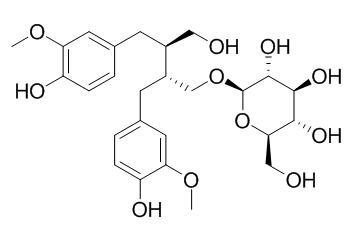Secoisolariciresinol monoglucoside
Secoisolariciresinol monoglucoside is a natural product from Linum usitatissimum L.
Inquire / Order:
manager@chemfaces.com
Technical Inquiries:
service@chemfaces.com
Tel:
+86-27-84237783
Fax:
+86-27-84254680
Address:
1 Building, No. 83, CheCheng Rd., Wuhan Economic and Technological Development Zone, Wuhan, Hubei 430056, PRC
Providing storage is as stated on the product vial and the vial is kept tightly sealed, the product can be stored for up to
24 months(2-8C).
Wherever possible, you should prepare and use solutions on the same day. However, if you need to make up stock solutions in advance, we recommend that you store the solution as aliquots in tightly sealed vials at -20C. Generally, these will be useable for up to two weeks. Before use, and prior to opening the vial we recommend that you allow your product to equilibrate to room temperature for at least 1 hour.
Need more advice on solubility, usage and handling? Please email to: service@chemfaces.com
The packaging of the product may have turned upside down during transportation, resulting in the natural compounds adhering to the neck or cap of the vial. take the vial out of its packaging and gently shake to let the compounds fall to the bottom of the vial. for liquid products, centrifuge at 200-500 RPM to gather the liquid at the bottom of the vial. try to avoid loss or contamination during handling.
Antioxidants (Basel).2021, 10(3):379.
VNU J Sci: Med. Pharm. Sci.2024, 40(2):21-30.
Research SPJ.2024, 0377.
LWT2020, 110397
Pharmacol Res.2022, 182:106346.
Agronomy 2021, 11(3),502.
Industrial Crops and Products2022, 188:115596.
Int. J. of Food Properties2017, S108-S118
Rec. Nat. Prod.2024, 18:4,405-418.
Plants (Basel).2022, 11(16):2126.
Related and Featured Products
BMC Plant Biology 2014, 14:82
Evidence for a Sequential Glucosylation of Secoisolariciresinol (SECO) into Secoisolariciresinol Monoglucoside (SMG) and Diglucoside (SDG) Lignans by the Flax Lu-UGT74S1 (Lu-UGTCL809) UDP-Glycosyltransferase[Reference:
WebLink]
CONCLUSIONS:
All UGTs displayed the characteristic plant secondary product glycosyltransferase (PSPG) motif.
Five of the UGTs were exclusively expressed in seed and the mRNA transcript expression of two revealed a clear correlation with SDG lignan biosynthesis in developing seed.
The seed-specific UGTs were expressed in yeast and the proteins reacted with secoisolariciresinol (SECO) in presence of UDP-glucose. Only Lu-UGTCL809 used SECO as substrate, forming first Secoisolariciresinol monoglucoside (SMG) and then SDG from the SMG intermediate. 3D structural modeling and ligand docking identified the amino acids within the PSPG motif that bind the phosphate and hydroxyl groups of UDP-glucose for both Lu-UGTCL809 (SER357 and Trp355) and Lu-UGTRP250 (Gln351, Ala352 and Gly261). Furthermore, whereas Lu-UGTCL809 binds to SECO by three hydrogen bonds between Cys335 and Gln337 and 4-OH and 3-OCH3 of SECO, Lu-UGTRP250 binds to SECO by a single hydrogen bond between Ala352 and the 9’hydroxyl group of SECO. Binding of Lu-UGTRP250 to the 9’-OH glycosylation site may explain the impaired SECO glucosylation by Lu-UGTRP250 for SMG synthesis.
CONCLUSIONS:
We report the first direct functional evidence for SECO glucosylation by a family 1 UGT.



